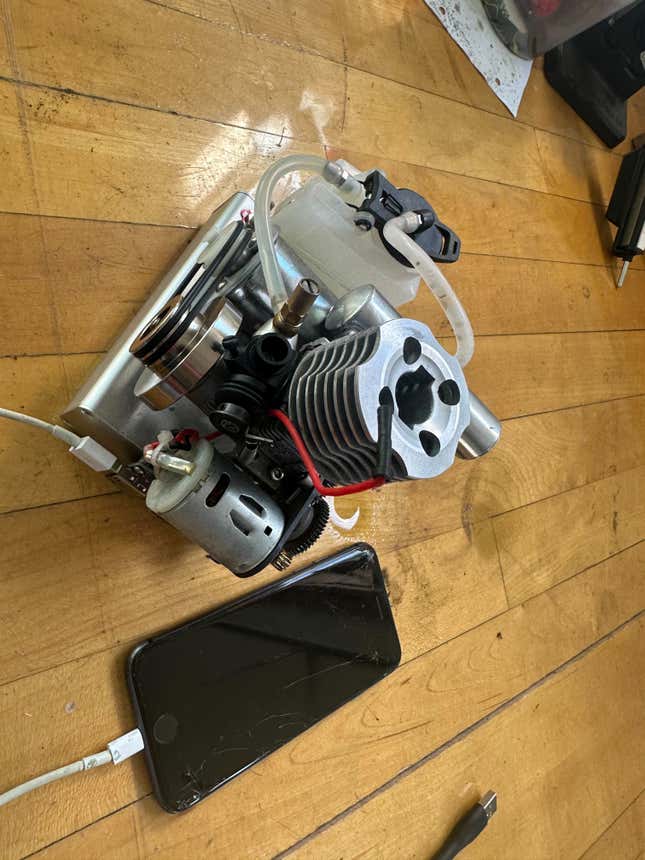If You're Thinking You'll Charge Your New iPhone 15 With Nitromethane Fuel, Read This First

As technology becomes more inescapable and we as consumers feel increasingly alienated, many have begun to seek out more authentic, tangible experiences. Some my find the process of crafting a perfect pour-over more satisfying than operating a Keurig, for example. Others may prefer the process of starting a tiny nitromethane powered engine every time they want to charge their phone as opposed to plugging that phone into the wall, and today there are several products available that deliver just such an experience.
Apple Is Still Trying to Make Your Phone Into Your Car Key
The explanation that I found online was that there were a lot of factories in China making these little nitro engines for R/C cars, boats, and planes, but now all those things are electric powered. So, what do you do with all the motors? If you search Ali Express, you can find all manner of inventive uses for them, including this phone charger, which I bought for around $100. You may be thinking of making the switch to a gasoline phone charger for your new iPhone, but before you make the leap, there are some things to consider.
In a lot of ways, my new gas charger is superior to the iPhone charger Apple gives you when you spend $1000 on a new iPhone. (I am assuming the phone still comes with a charger.) First of all, it’s mostly made of stainless steel and aluminum, not plastic. It also has a digital readout to show what kind of voltage it’s producing, and it doesn’t need to be plugged into the wall. Incredibly, this model is equipped with an electric push-button starter. That’s convenient, but if you haven’t tried starting a nitro motor lately, you may not remember that you need a separate device to warm the glow plug before you hit start.
Photo: Rory Carroll
As far as negatives, it is a little bulkier than the standard iPhone charger, and it requires nitromethane fuel, which you might not have on-hand but is available online and at most hobby stores. I found a gallon of it for about $30 at Trains & Things Hobbies. That’s not cheap, and it’s made worse by the fact that the phone charger is surprisingly inefficient. A full tank of fuel lasted about 12 minutes and got my old iPhone 8 to about 6 percent battery. Some of that could be limitations on my old phone’s charging speed.

Photo: Rory Carroll
Another shortcoming, at least with my particular phone charger, is that a fair amount of oil comes out of the exhaust when it runs, usually pooling on the table next to the exhaust outlet and spattering everything nearby. This isn’t a huge concern in my shop which is already pretty grimy. I could see it being an annoyance in an overly stuffy office environment or an operating room. A quick forum search suggests that my phone charger could be running a bit rich, but that it’s normal for some of the oil from the nitro fuel to make it out of the exhaust. The exhaust is a bit louder than a standard iPhone charger, and it does does sting the eyes a bit — maintaining charge-discipline all day with this charger will take a level of dedication. I could see myself getting used to running the motor on my desk through the work day, possibly with a respirator or a vent system. It could even be seen as a kind of aggressive white-noise generator.
It doesn’t fast charge, and I’m not even totally sure it’ll run long enough to charge an iPhone fully — it gets pretty hot. The exposed gears and hot surfaces are another thing you don’t have to worry about with a standard iPhone charger, and as you can see in the video, the little thing does like to kind of vibrate itself around. I also wonder if the variability in electrical output is good for the iPhone battery over time.
It’s not all bad, and whether you’re going to make the switch yourself will be a matter of your personal preference. Some just prefer the sound of a gas engine when they’re charging their phone, some don’t. It goes without saying that under the right circumstances, a nitro-powered charger could be a real life saver.
That said, my personal preference will be to continue using a conventional wall charger most of the time, while making use of the gas charger on weekends or on fun, after work charges. In my world, it’s a novelty. But, I’ll be keeping an eye on the nitro-powered charger space as it evolves.



